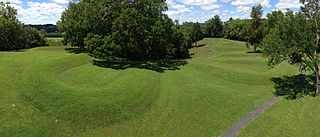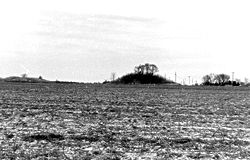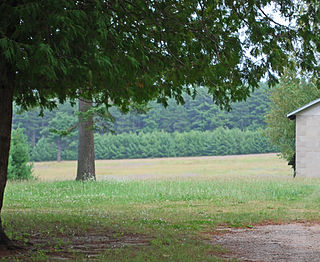Related Research Articles

The Great Serpent Mound is a 1,348-foot-long (411 m), three-foot-high prehistoric effigy mound located in Peebles, Ohio. It was built on what is known as the Serpent Mound crater plateau, running along the Ohio Brush Creek in Adams County, Ohio. The mound is the largest serpent effigy in the world.
Sheguiandah is an archaeological site and National Historic Site of Canada. It is located on the northwestern shore of Manitoulin Island in Manitoulin District, Ontario. The site has remains from 9000 years of occupation, from the Paleo-Indian period through the Archaic period until the Middle Woodland period. Throughout this time, the people of the area travelled to the site to quarry from its quartzite outcroppings for use in toolmaking.

The Stanfield-Worley Bluff Shelter, located on private property in Colbert County in northwestern Alabama, United States, is one of the most important prehistoric sites excavated in the state due to the archeological evidence deposited by the Paleo-Indians who once occupied the rock shelter. Lying in Sanderson Cove along a tributary of Cane Creek approximately seven miles (11 km) south of the Tennessee Valley, the shelter and the high bluffs of the surrounding valley provided a well-protected environment for the Native American occupants.

The Lindenmeier site is a stratified multi-component archaeological site most famous for its Folsom component. The former Lindenmeier Ranch is in the Soapstone Prairie Natural Area, in northeastern Larimer County, Colorado, United States. The site contains the most extensive Folsom culture campsite yet found with calibrated radiocarbon dates of c. 12,300 B.P.. Artifacts were also found from subsequent Archaic and Late pre-historic periods.

The Eaker site (3MS105) is an archaeological site on Eaker Air Force Base near Blytheville, Arkansas, that was declared a National Historic Landmark in 1996. The site is the largest and most intact Late Mississippian Nodena phase village site within the Central Mississippi Valley, with archaeological evidence indicating a palisaded village some 50 acres (20 ha) in size, with hundreds of structures. The site's major period of occupation was 1350–1450 CE, although evidence of occupation dates back to 600 CE. The site is also hypothesized to have been occupied by the Quapaw prior to a migration further south, after which they made contact with Europeans in the late 17th century.

The Kincaid Mounds Historic Site c. 1050–1400 CE, is a Mississippian culture archaeological site located at the southern tip of present-day U.S. state of Illinois, along the Ohio River. Kincaid Mounds has been notable for both its significant role in native North American prehistory and for the central role the site has played in the development of modern archaeological techniques. The site had at least 11 substructure platform mounds, and 8 other monuments.

The Modoc Rock Shelter is a rock shelter or overhang located beneath the sandstone bluffs that form the eastern border of the Mississippi River floodplain at which Native American peoples lived for thousands of years. This site is significant for its archaeological evidence of thousands of years of human habitation during the Archaic period in the Eastern United States. It is located on the northeastern side of County Road 7 southeast of Prairie du Rocher in Randolph County, Illinois, United States. It was declared a National Historic Landmark in 1961.

Jaketown Site is an archaeological site with two prehistoric earthwork mounds in Humphreys County, Mississippi, United States. While the mounds have not been excavated, distinctive pottery shards found in the area lead scholars to date the mounds' construction and use to the Mississippian culture period, roughly 1100 CE to 1500 CE.

The Hardaway Site, designated by the Smithsonian trinomial 31ST4, is an archaeological site near Badin, North Carolina. A National Historic Landmark, this multi-layered site has seen major periods of occupation as far back as 10,000 years. Materials from this site were and are used to assist in dating materials from other sites in the eastern United States. The site was declared a National Historic Landmark in 1990.
The Walker Gilmore site, designated by the Smithsonian trinomial 22CC28, is a prehistoric archaeological site near Murray, Nebraska. First formally investigated in 1915, it is the type site for the Sterns Creek focus, the first Woodland period culture identified in Nebraska. It was designated a National Historic Landmark in 1964.

Shawnee-Minisink Site is a prehistoric archaeological site located in Smithfield Township, Monroe County, Pennsylvania in the upper Delaware Valley. It was the site of a Paleoindian camp site. It was added to the National Register of Historic Places in 2007.

The Juntunen site, also known as 20MK1, is a stratified prehistoric Late Woodland fishing village located on the western tip of Bois Blanc Island. It was listed on the National Register of Historic Places in 1978.
The Spanish Fort Site (22-SH-500) is an archaeological site in the Delta region of the U.S. state of Mississippi. It is one of three major earthwork sites in the far southern portion of the Yazoo River valley, and it has been designated a historic site because of its archaeological value. Despite its name, the site was not built by the Spanish, and its original purpose is believed to have been ceremonial, not martial.

The Skegemog Point Site, also known as the Samels Field Site or Samels Site and designated 20GT2, is an archaeological site located on the property of the Samels Farm at 8298 Skegemog Point Road, near Williamsburg, Michigan. Material at the site spans over 10,000 years, and the site is unique in that, due to glacial rebound, it is horizontally stratified rather than vertically stratified. The site was listed on the National Register of Historic Places in 1972.
The Rumford Archaeological Sites are a collection of prehistoric Native American sites in the vicinity of the Androscoggin River near Rumford, Maine. These six sites provide a window of observation into the movements and practices of Native Americans from c. 7,000 BCE to the Late Woodland period and contact with Europeans. These sites are the subject of three separate listings on the National Register of Historic Places in 1972: the Rumford Falls I-IV Sites, the Rumford V Site, and the Town of Rumford Site. The locations of these sensitive sites are not generally publicized.
The Rock Creek Archeological District is a pair of archaeological sites near Maud, Colbert County, Alabama. The sites contain remnants from the Archaic, Gulf Formational, Woodland, and Mississippian Periods. One of the sites, ACt 44, shows evidence of two major habitations, a hunting camp from the Late Archaic period and a Late Mississippian farm village, although ceramics and arrowheads from other eras have also been recovered. Most artifacts from the other site, ACt 45, date from the Gulf Formational period. The sites were discovered by National Park Service archaeologist A. Wayne Prokopetz in 1975, with major surveys being completed by Christopher E. Hamilton in 1977 and by Memphis State University researchers in 1980. The district was listed on the National Register of Historic Places in 1990.
The Brockway Site, designated Site 90.3 by the Maine Archaeological Survey, is a prehistoric archaeological site in Milo, Maine. Long known to local amateur archaeologists, the site was formally tested in 1986, yielding evidence of a well-stratified site containing thousands of artifacts dating as far back as c. 2000 BCE. These types of sites are rare in the interior of Maine. The site was listed on the National Register of Historic Places in 1987.

The Moccasin Bluff site is an archaeological site located along the Red Bud Trail and the St. Joseph River north of Buchanan, Michigan. It was listed on the National Register of Historic Places in 1977, and has been classified as a multi-component prehistoric site with the major component dating to the Late Woodland/Upper Mississippian period.
The King Coulee Site is a prehistoric Native American archaeological site in Pepin Township, Minnesota, United States. It was listed on the National Register of Historic Places in 1994 for having state-level significance in the theme of archaeology. It was nominated for being a largely undisturbed occupation site with intact stratigraphy and numerous biofacts stretching from the late Archaic period to the Oneota period. This timeframe spans roughly from 3,500 to 500 years ago. The site yielded the oldest known evidence of domesticated plants in Minnesota: seeds dated to 2,500 years ago from the squash Cucurbita pepo.
The Fisher Mound Group is a group of burial mounds with an associated village site located on the DesPlaines River near its convergence with the Kankakee River where they combine to form the Illinois River, in Will County, Illinois, about 60 miles southwest of Chicago. It is a multi-component stratified site representing several Prehistoric Upper Mississippian occupations as well as minor Late Woodland and Early Historic components.
References
- ↑ "National Register Information System". National Register of Historic Places . National Park Service. January 23, 2007.
- 1 2 "Hester Site". National Historic Landmark summary listing. National Park Service. Retrieved October 21, 2007.
- 1 2 3 "National Historic Landmark Nomination : Hester Site" . Retrieved October 31, 2011.
